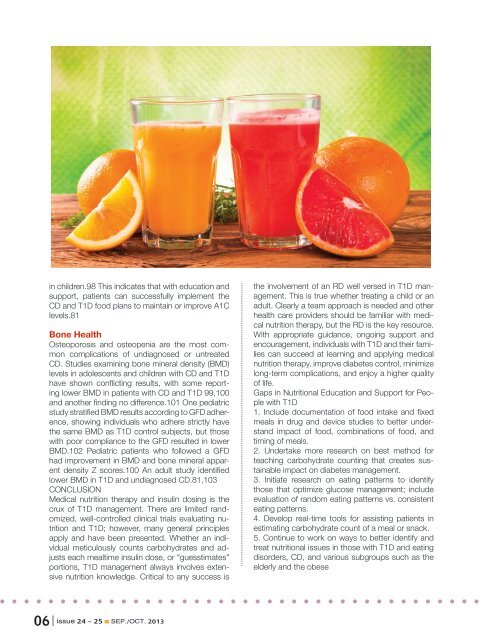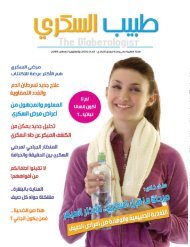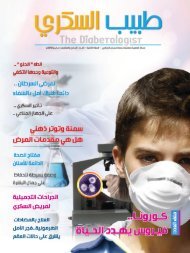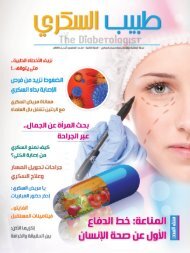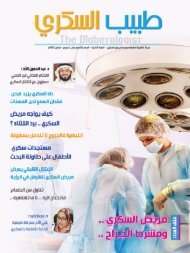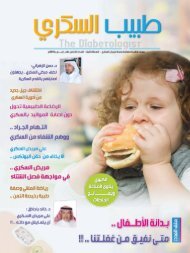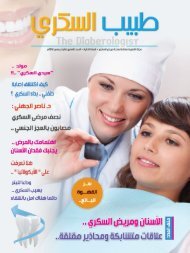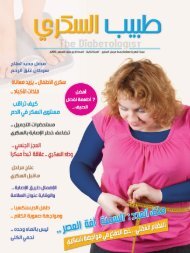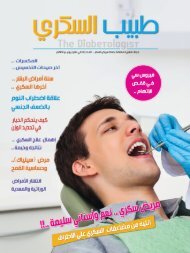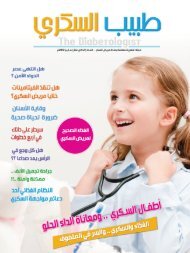The Diabetologist #24+25
طبيب السكري - العدد 24+25
طبيب السكري - العدد 24+25
You also want an ePaper? Increase the reach of your titles
YUMPU automatically turns print PDFs into web optimized ePapers that Google loves.
in children.98 This indicates that with education and<br />
support, patients can successfully implement the<br />
CD and T1D food plans to maintain or improve A1C<br />
levels.81<br />
Bone Health<br />
Osteoporosis and osteopenia are the most common<br />
complications of undiagnosed or untreated<br />
CD. Studies examining bone mineral density (BMD)<br />
levels in adolescents and children with CD and T1D<br />
have shown conflicting results, with some reporting<br />
lower BMD in patients with CD and T1D 99,100<br />
and another finding no difference.101 One pediatric<br />
study stratified BMD results according to GFD adherence,<br />
showing individuals who adhere strictly have<br />
the same BMD as T1D control subjects, but those<br />
with poor compliance to the GFD resulted in lower<br />
BMD.102 Pediatric patients who followed a GFD<br />
had improvement in BMD and bone mineral apparent<br />
density Z scores.100 An adult study identified<br />
lower BMD in T1D and undiagnosed CD.81,103<br />
CONCLUSION<br />
Medical nutrition therapy and insulin dosing is the<br />
crux of T1D management. <strong>The</strong>re are limited randomized,<br />
well-controlled clinical trials evaluating nutrition<br />
and T1D; however, many general principles<br />
apply and have been presented. Whether an individual<br />
meticulously counts carbohydrates and adjusts<br />
each mealtime insulin dose, or “guesstimates”<br />
portions, T1D management always involves extensive<br />
nutrition knowledge. Critical to any success is<br />
the involvement of an RD well versed in T1D management.<br />
This is true whether treating a child or an<br />
adult. Clearly a team approach is needed and other<br />
health care providers should be familiar with medical<br />
nutrition therapy, but the RD is the key resource.<br />
With appropriate guidance, ongoing support and<br />
encouragement, individuals with T1D and their families<br />
can succeed at learning and applying medical<br />
nutrition therapy, improve diabetes control, minimize<br />
long-term complications, and enjoy a higher quality<br />
of life.<br />
Gaps in Nutritional Education and Support for People<br />
with T1D<br />
1. Include documentation of food intake and fixed<br />
meals in drug and device studies to better understand<br />
impact of food, combinations of food, and<br />
timing of meals.<br />
2. Undertake more research on best method for<br />
teaching carbohydrate counting that creates sustainable<br />
impact on diabetes management.<br />
3. Initiate research on eating patterns to identify<br />
those that optimize glucose management; include<br />
evaluation of random eating patterns vs. consistent<br />
eating patterns.<br />
4. Develop real-time tools for assisting patients in<br />
estimating carbohydrate count of a meal or snack.<br />
5. Continue to work on ways to better identify and<br />
treat nutritional issues in those with T1D and eating<br />
disorders, CD, and various subgroups such as the<br />
elderly and the obese<br />
06<br />
issue 24 - 25 < SEP./OCT. 2013


